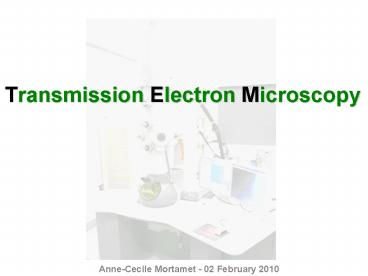Transmission Electron Microscopy - PowerPoint PPT Presentation
1 / 13
Title:
Transmission Electron Microscopy
Description:
To examine internal morphology of polymers from segmental ... instrument used to cut thin ... You are here TEM Suite Biomedical Science Department ... – PowerPoint PPT presentation
Number of Views:833
Avg rating:3.0/5.0
Title: Transmission Electron Microscopy
1
Transmission Electron Microscopy
Anne-Cecile Mortamet - 02 February 2010
2
WHY?
- To examine internal morphology of polymers from
segmental to atomic level - e.g. block copolymers, crystalline polymers,
vesicles and polymers in solution - Image contrast is produced through electron
scattering by the atomic nuclei of the sample
3
PRINCIPLE
- Beam of electrons transmitted through an ultra
thin specimen - Image formed, magnified and detected through a
sensor (CCD camera) - Contrast within the sample enhanced by the use of
stains (heavy metal complexes selectively
deposited in the sample e.g. RuO4, OsO4)
4
Cryomicrotomy
- Microtome instrument used to cut thin specimen
for microscopic study - Cryomicrotome useful for polymers that are
rubbery at room temperature possibility to cut
at temperature below Tg
5
Ultra CRYomicrotomy
- Cutting thin polymer sections by means of a
glass knife (for trimming) and diamond knife (for
cutting specimen up to 10nm thick) at low
temperatures (up to -200oC)
SAMPLE CHAMBER
COOLING SYSTEM Liquid nitrogen dewar
Sample support MESH GRID
6
EXAMPLES of TEM images
Phase separated structure of a polyurethane
elastomer sample ACM April 2009
SBS block copolymer structure
Typical TEM image of a SBS sample
7
ADVANTAGES
?
- TEM can magnify over 500 000 times
- It can resolve details as small as 1nm (better
resolution than SEM) - Smallest observable polymer structure crystal
lattice
8
LIMITATIONS
?
- Extensive sample preparation to allow the
specimen to be electron transparent (patience and
time required!) - Samples can be damaged by the electron beam
irradiation they have to withstand high vaccum - Small field of view restricts possibilities to
get characteristics of the whole sample
9
WHERE?
10
(No Transcript)
11
CONTACTS
- Dr Svetomir Tzokov s.b.tzokov_at_sheffield.ac.uk
- Mr Chris Hill c.j.hill_at_sheffield.ac.ukgt
TRAINING REQUIRED FOR PREPARING AND IMAGING
SAMPLES
12
REFERENCES
- 1 Transmission Electron Microscopy A Textbook
for Materials Science, by David B. Williams
(Author), C. Barry Carter - 2 D. T. Grubb and L. C. Sawyer, Polymer
Microscopy, 2nd ed., Chapman and Hall, London,
1996 - 3 N. Reid, Ultramicrotomy, In A. Glauert
(editor), Practical Methods in Electron
Microscopy, Vol 3, North Holland Publishing Col,
Amsterdam, 1974
13
Transmission Electron Microscopy
- Ultra Cryomicrotomy for sample preparation
Anne-Cecile Mortamet - 02 February 2010































